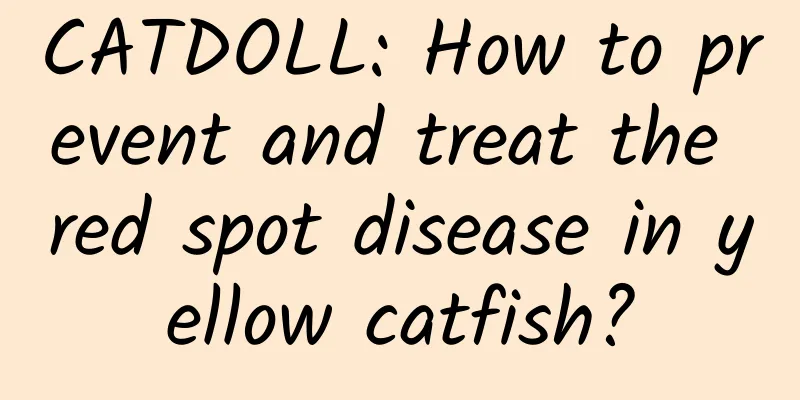CATDOLL : CATDOLL: How to prevent and treat the red spot disease in yellow catfish?

How to prevent and treat the red spot disease of yellow catfish?Since your description is not very clear, I cannot make a definite judgment. I can only tell you all the knowledge about diseases of yellow catfish, so that you will know how to prevent and treat them when you encounter various situations in the future. Although yellow catfish has strong disease resistance, as the stocking density increases, coupled with improper management and operation, diseases often occur, resulting in a lower survival rate. Therefore, strengthening disease prevention and control is a key measure to ensure aquaculture production and economic benefits. The common diseases of yellow catfish and prevention and control methods are introduced as follows: 1. Field bacterial enteritis 1.1 The disease is caused by infection with Aeromonas punctata. 1.2 Symptoms The abdomen of the sick fish is swollen, the anus is red and swollen, and yellow mucus flows out of the anus when the abdomen is gently pressed. The intestine is inflamed, light red, and filled with blood and pus. The sick fish leave the group and go to the shore, move slowly, and have a decreased appetite. 1.3 Prevention and control ① Do not feed rotten and moldy baits. Disinfect live baits with 2% to 3% salt before feeding. Add 0.1% fresh garlic juice to the bait regularly. ② Spray 0.3g/m3 of strong chloramine or 0.5g/m3 of chloramine throughout the pond. ③ Feed medicated baits, add 0.05g of oxytetracycline per kg of bait, and use it for 10 consecutive days. ④ Feed sulfaguanidine medicated baits, use 1og of medicine for every 100kg of fish on the first day, and reduce the dosage by half on the 2nd to 6th days. 2 Hemorrhagic edema 2.1 The cause of the disease is bacterial or viral infection. 2.2 Symptoms The fish has yellowish color, increased mucus, broken and congested pharyngeal skin with round holes, distended abdomen, swollen and red anus, congested head, congested base of pectoral and pelvic fins, ulcerated fins, bile extravasation. A large amount of blood or yellow jelly is accumulated in the abdominal cavity, the stomach and intestines are empty, the liver is earthy yellow, the spleen is necrotic, and there are moldy black spots on the kidneys. 2.3 Prevention and control ① Disinfect water bodies with 0.5g/m3 of dibromocyanine for 3 consecutive days; ② Feed medicated bait, add 0.79 tetracycline or 0.5g ciprofloxacin per kg of bait, and feed continuously for one week; ③ Increase the amount of water change and disinfect regularly with 15-20g/m3 of quicklime. 3 Saprolegniasis 3.1 The cause of the disease is water-borne mold. 3.2 Symptoms The fish swim slowly, have cotton-like attachments on their bodies, become thin and weak, and die. This disease is most likely to occur when the water temperature is low, and is often caused by improper operation during net pulling and transportation. 3.3 Prevention and control ① During the process of fishing, transportation and stocking, operate with caution to avoid injuring the fish as much as possible; ② Soak in 20g/m3 of Saprolegnia littoralis for 105 minutes; ③ Sprinkle 0.3g/m3 of Saprolegnia littoralis throughout the pond; ④ First soak the diseased fish in 5% salt water for 5 minutes, and then soak in a solution made of 100k added 800,000 units of penicillin for 10 minutes. 4 Trichodinasis and tricholoma 4.1 The disease is caused by large numbers of wheelworms or oblique tube worms parasitizing the gills and skin of fish, which mainly harm the yellow catfish seedlings. 4.2 Symptoms The sick fish are restless, float to the upper layer and swim wildly, or spin on the water surface with their abdomen facing upwards. Microscopic examination shows a large number of wheelworms or oblique tube worms parasitizing on the gill filaments and skin mucus. 4.3 Prevention and control ①Spray 0.7g/m3 of copper sulfate and ferrous sulfate mixture (5:2) throughout the pond; ②Spray 0.3-0.4g/m3 of compound fish and insect cleaner throughout the pond; ③Spray 0.15g/m3 of fish and insect killer throughout the pond; ④Clean and disinfect the pond thoroughly with quicklime. 5 Ichthyophthirius 5.1 The disease is caused by Ichthyophthirius multiflorus infection in the skin and gills of fish. 5.2 Symptoms: Small white spots can be seen on the skin of the diseased fish. Use tweezers to remove the small white spots and place them on a glass slide. Add a drop of clean water and the small white spots can be seen moving slowly in the water. Observe under a microscope to confirm the diagnosis. 5.3 Prevention and control ① Soak the fish body in 50g/m3 of formalin for 10 minutes; ② Sprinkle 0.3-0.4g/m3 of compound fish worm throughout the pond; ③ Bathe in 20g/m3 of water mold net for 15 minutes. 6 Dactylariasis and trichodinasis 6.1 The disease is caused by Dactylopius or Trichodina parasitizing the gill filaments and skin. 6.2 Symptoms The gill filaments of the diseased fish are swollen, the gills are partially pale, the fish have difficulty breathing, the body is emaciated, the fish swims slowly, and the fish loses its appetite and dies. 6.3 Prevention and control: ①Spray 90% crystal trichlorfon 0.5g/m3 throughout the pond; ②Spray compound fish and insect net 0.4g/m3 throughout the pond; ③Spray insecticide 0.15g/m3 throughout the pond. 7 Anchorhead disease 7.1 The cause of the disease is parasitic infection by anchorhead fish. 7.2 Symptoms The fish are restless and swim slowly. The parasitic parts are congested, inflamed, swollen and have red spots. The anchorhead parasites are visible to the naked eye. 7.3 Prevention and control: ①Spray 0.5g/m3 of 90% crystal dichlorvos throughout the pond; ②Spray 0.15g/m3 of fish and insect killer throughout the pond. In short, the principle of "prevention before disease, early treatment when diseased, prevention is better than treatment" should be adopted to treat yellow catfish diseases, so as to prevent or reduce the losses caused by dead fish. Pay attention to maintaining fresh water quality, and be meticulous in operations such as pulling nets and transporting. Yellow catfish is a fish with a large scale, and its tolerance to drugs is not as good as that of domestic fish, so the dosage of drugs must be accurately controlled. Keep your skin clean This is not internal medicine. What kind of fish is this? What does it eat?Yellow catfish (Pelteobagrus fulvidraco) belongs to the order Siluriformes, family Pelteobagrus, genus Pelteobagrus. Common name: Yellow cartfish. English name: Yellow cartfish. The body is long, the abdomen is flat, and the rear part of the body is slightly flattened. The head is large and flat, the snout is round and blunt, the mouth is large and lower, the upper and lower jaws have fine hair-like teeth, and the eyes are small. There are 4 pairs of whiskers, and most species have particularly long whiskers on the upper jaw. There is no scale. The dorsal and pectoral fins have well-developed hard spines, which can make sounds when the spines move. The pectoral fins are short. The body is greenish-yellow, and most species have irregular brown spots; the fins are gray-black with yellow. They live in the bottom of lakes and slow-flowing rivers, especially in shallows with decaying materials and silt. They lurk in the bottom of the water body during the day and float to the upper layer of the water to find food at night. They gather in deep water of tributaries in winter. They have strong adaptability to the environment, so they can survive in adverse environmental conditions. Yellow catfish is a typical omnivorous fish. Juveniles mainly feed on zooplankton and larvae of aquatic insects, while adults feed on small fish and invertebrates. Yellow catfish reaches sexual maturity at the age of 2. From May to July every year, male fish swim to the silt and clay with dense aquatic plants in the coastal area (water depth of 8-40 cm), use the pectoral fins to rotate intermittently on the mud bottom, and dig a small mud pit, which is the fish nest for spawning. After building the nest, the male fish stays in the nest, waiting for the female fish to come and lay eggs and fertilize in the nest. Spawning activities are mostly carried out at night when the climate changes from sunny to rainy. After laying eggs, the female fish leaves the nest to look for food. Only the male fish stays near the nest to guard the developing eggs and fry until the fry can leave the nest and swim freely (about 7-8 days). Yellow catfish is widely distributed. It is found in all waters of China except the western plateau. Although it is small, it has a large yield. Its meat is tender, without small thorns, and is rich in fat. Its protein content is 16.1% and its fat content is 0.7%. It is a common edible fish in my country. There are many types of yellow catfish, and common species include shorthead catfish (P.eupogon, English name: Shorthead catfish), darkbarbel catfish (P.vachellii, English name: Darkbarbel catfish), shiny catfish (P.nitidus, English name: Shining catfish), etc. The dorsal and pectoral fin spines of yellow catfish have venom glands, making it one of the most toxic freshwater venomous fish. Immediately after being stabbed, there will be a strong burning pain, which often causes lacerations, bleeding, local swelling, and fever due to the puncture. The severe pain in the affected area will stop after half an hour to an hour. Yellow catfish is often used as medicine. Its meat is sweet and flat, has a diuretic effect, and can be used to treat edema, sore throat and other symptoms. Breeding technology The breeding pond should be 3-5 mu per pond, 1.5-2.0 meters deep, with good water exchange conditions and equipped with an aerator. Before stocking, 150 kg of quicklime per mu of dry pond should be applied for disinfection, and new water should be injected after 3 days. Seedlings can be stocked after fertilization. For the main breeding, 1,000 fry of 5-8 cm in size are released per mu, and some silver carp, bighead carp, grass carp and crucian carp are reasonably matched. Fresh small fish can be fed as feed. Small fish can be minced into fish paste during the fry stage. As they grow up, they can be chopped into meat pieces and fed 2-3 times a day. The daily feeding amount is 5-10% of the fish body weight. The feeding method is to set up a feeding point in the downwind of the pond, and use a 20-mesh net to enclose an area of about 5-10 square meters. The net is higher than the water surface and 50 cm from the bottom of the pond. The feed is placed in it. When the feed floats in the net, it will not disperse. The yellow catfish will come up from the water to feed. In the hot season, pay attention to prevent the water quality from deteriorating, replace the new water appropriately, and control the water color transparency to 20-30 cm; apply quicklime once every 10-15 days, 15 kg per mu of water and sprinkle it all over the pond; at the same time, pay attention to start the aerator to maintain dissolved oxygen in the water. The output of one year of breeding is 200-300 kg. Yellow catfish can also be raised in combination. About 200 fish species are released per mu. Without increasing the amount of feed, it can be used to remove small fish, shrimps and aquatic insects in the pond, and a certain yield can be obtained. [Edit this section] Polyculture technology Yellow catfish is a benthic omnivorous fish with tender meat, rich nutrition and high economic value. It is a breeding species with great market potential. Yellow catfish has strong adaptability and grows slower than carp fish, but it grows faster for the species itself. The fry bred in the same year can reach the commercial specifications in the same year, and the group yield is high. Because the current artificial breeding technology is not yet mature, large-scale artificial breeding has certain difficulties, so it is imperative to carry out polyculture. Polyculture of yellow catfish in fish ponds has the following advantages: First, it can feed on low-value small fish and shrimps, fish bait, organic debris, zooplankton, etc. in the pond, thereby increasing the net yield of the fish pond. Second, yellow catfish feeds on parasites such as anchorhead bream in the water, which can reduce the occurrence of fish diseases. Third, without affecting the yield of the main culture species, the production of yellow catfish can be increased by 5 kg to 20 kg per mu, and the benefit per mu is more than 100 yuan. The mixed culture technology is introduced as follows: 1. Mixed culture in fish ponds There are no strict requirements for the main fish species in the fish ponds for co-culturing yellow catfish. Yellow catfish can be co-cultured in fish ponds that breed the four major carps and fish ponds that mainly raise grazing fish (such as carp, crucian carp, tilapia, and freshwater silver pomfret). The fish pond area is 20 to 30 mu, the water depth is 2 to 2.5 meters, the water source is sufficient, the water quality is good, and the drainage is convenient. Generally, 40 to 50 yellow catfish are placed per mu, with a size of 3 cm/tail to 4 cm/tail, which can increase the yellow catfish yield by 5 kg to 8 kg per mu. 2. Mixed culture in broodstock pond Mixed breeding in broodstock ponds can not only make full use of the water space of broodstock ponds and improve the utilization rate of broodstock ponds, but also the yellow catfish can eat some small wild fish in the broodstock ponds that compete with the broodstock for food and oxygen. After the artificial breeding of broodstock is completed, 40 to 60 yellow catfish are released per mu, with a size of 2 cm/tail to 3 cm/tail, which can increase the yellow catfish yield by 6 kg to 10 kg per mu. 3. Mixed breeding in crab ponds Raising yellow catfish in crab ponds can make full use of the natural bait biological resources in crab ponds. Generally, the area of crab ponds is 30 to 50 mu, and the coverage rate of aquatic plants is about 50%. After the crabs are released, 30 to 50 yellow catfish are released per mu, with a size of 3 cm/tail to 5 cm/tail, which can increase the yellow catfish per mu by 5 kg to 10 kg. 4. Mixed culture in rivers and ditches There are many low-value wild fish in the river, and mixed culture of yellow catfish can save artificial bait. Generally, 40 to 60 yellow catfish are released per mu, with a size of 2 cm/tail to 4 cm/tail, which can increase the yellow catfish by 6 kg to 12 kg per mu. 5. Polyculture on large water surfaces The large-scale mixed culture of yellow catfish has a high group yield, which does not affect the yield of the main culture species and does not require additional feeding. Generally, 40 to 60 yellow catfish are released per mu, with a size of 3 cm/tail to 4 cm/tail, which can increase the yellow catfish yield by 8 kg to 15 kg per mu. Regardless of the mixed breeding method adopted, the following matters should be noted in breeding management: 1. Maintain a high level of dissolved oxygen in the water. Yellow catfish has a high requirement for dissolved oxygen in the pond water, so when mixed breeding is required, the water quality must be fresh and the dissolved oxygen must be sufficient. New water should be added in time during the growing season, and the water should be changed frequently during the high temperature season. It is better to maintain a micro-flowing water. 2. Maintain reasonable stocking density and stocking specifications. According to the biomass of bait in the water body, scientifically and reasonably determine the mixed culture ratio and stocking specifications. Generally, 30 to 60 fish are suitable for mixed culture in water bodies, and the stocking specifications are 3 cm/fish to 4 cm/fish. If the density is too high and the specifications are too small, the market specifications cannot be reached by the end of the year. 3. After the fish pond is co-cultured with yellow catfish, it is no longer suitable to co-culture other carnivorous fish. Yellow catfish should not be co-cultured in the breeding ponds of freshwater swamp shrimp and freshwater crayfish. 4. During the breeding process, if the size of the yellow catfish is too small, it means that the natural bait biomass in the fish pond is insufficient. You can add small fish and shrimp, domestic fish summer flowers or feed them artificially prepared special yellow catfish bait. When feeding artificial bait, you should feed the main species first (put it into the shallow water area) and then feed the yellow catfish (put it into the deep water area). Yellow catfish has the habit of hiding during the day and coming out at night, so feeding should be mainly done at night. 5. Raising catfish in crab ponds is easy to cause competition for ecological positions because river crabs and catfish are in the same water layer. Therefore, sufficient natural bait organisms must be kept in the crab pond, otherwise it will affect the breeding effect of catfish. 300 kg to 400 kg of snails and some roe-bearing crucian carps and shrimps with eggs can be put into the crab pond in advance, allowing them to reproduce naturally and provide free feeding for river crabs and catfish. 【Common Disease Control Technology for Pelteobagrus fulvidraco】 Pelteobagrus fulvidraco is a widely distributed bottom-dwelling economic fish in my country's freshwater bodies. While increasing the yield per unit area, increasing the stocking density and expanding the aquaculture area, the diseases of Pelteobagrus fulvidraco are gradually increasing and the harm is increasing. Therefore, the main control technologies for several common diseases are proposed. 1. Causes of mechanical injury Because yellow catfish likes to live in groups and has hard spines on its pectoral and dorsal fins, it is easy to cause mechanical damage to the fish skin, such as abrasions and fin cracks, during production operations and transportation, leading to secondary bacterial and fungal infections, with fin rot and water mold growth as the main symptoms. Prevalence The main causes are injuries during cage culture operations and large-sized fish species after long-distance transportation. Disease Control Technology Be careful when pulling the net for exercise and transportation. When the fry emerge, the temporary cage time should not be too long, and the stocking density of the temporary cage should be reduced as much as possible. Oxytetracycline can be added in appropriate amounts to the transportation water, and the fingerlings should be washed and disinfected with low-concentration potassium permanganate or 30% salt water solution before entering the pond or cage. 2. Hemorrhagic edema Causes Caused by bacterial infection. The body surface of the sick fish turns yellow, and the mucus increases; the pharyngeal skin is damaged and congested with round holes; the abdomen is swollen, the anus is red and swollen, and turned outward; the head is congested, the dorsal fin is swollen, the base of the pectoral and pelvic fins is congested, the fin rays are ulcerated, and even the abdomen is longitudinally cracked from the pectoral fin to the pelvic fin, and bile leaks out. A large amount of blood or yellow jelly is accumulated in the abdominal cavity, there is no food in the gastrointestinal tract, the stomach is pale, the intestine is filled with yellow thick liquid, the liver is khaki, the spleen is necrotic, and there are moldy black spots on the kidneys. The disease is most harmful during the breeding of seedlings or adult fish, especially during the seedling cultivation process, with a mortality rate of up to 80%. In the hot season, the disease is prone to outbreaks and spreads rapidly. Disease Control Technology During the breeding process, close attention should be paid to water quality, good environmental conditions should be maintained, and the dissolved oxygen content should be kept above 5mg/L; the stocking density of fry should be appropriately reduced; after the disease occurs, the water body should be disinfected once a day for 3 consecutive days. When feeding fish paste, 1% salt should be added to the bait every day. 3. Saprolegniasis Causes It is caused by infection with Saprolegnia. When Saprolegnia first parasitizes, the naked eye cannot see any abnormality. When the naked eye can see it, the hyphae have already invaded the wound and grown and spread inward and outward, and appear as grayish-white cotton-like attachments. The sick fish swim abnormally and become restless until the muscles rot, lose appetite, become emaciated and die; if the fish eggs are covered with hyphae, they become white fluff balls, and the moldy eggs become dead fish eggs. It seriously harms the fish eggs in incubation and the seedlings and adult fish with wounds on the fish body surface. This disease is most likely to occur when the water temperature is low, and is mostly caused by improper operation during the process of pulling the net, dividing the box, and transportation. Disease Control Technology During the process of fishing, transportation and stocking, try to avoid fish injuries and control the stocking density appropriately. Before stocking the fish, disinfect them with a 2-3% saline solution, spray the whole pond with methylene blue to make the water concentration reach 2mg/L, and spray it again after 2 days. Fertilized eggs should be strictly disinfected before hatching, and the water temperature should be controlled at 26-28℃. Fertilized eggs should be disinfected again during the hatching process. 4. Enteritis Causes It is caused by infection with Aeromonas punctata. The abdomen of the diseased fish is swollen, the anus is red and swollen, and yellow mucus flows out of the anus when the abdomen is lightly pressed. When the fish abdomen is opened, the esophagus and foregut of the fish with mild disease are congested and inflamed. In severe cases, the whole intestine is inflamed and light red, and blood and pus are blocked in the intestine. The sick fish swim alone, move slowly, and have a decreased appetite. Enteritis mainly harms fish species and adult fish. The bacterial infection may come from the bottom mud of the aquaculture waters. The zooplankton, water earthworms and fish pulp in artificial compound feeds consumed by the fish may also carry the bacteria. The peak of the epidemic often occurs when the water temperature is 25-30℃. Disease Control Technology The pond should be cleaned and disinfected thoroughly; do not feed moldy or rotten feed; live bait should be disinfected with 2-3% salt solution, and 1% salt or 0.1% fresh garlic juice should be added to the feed regularly for feeding; spray 0.5g of dibromocyanine per cubic meter throughout the pond. 5. Trichodiniasis Causes It is caused by the parasitic wheelworm. The sick fish are restless and when seriously infected, they swim wildly along the edge of the pond, showing a "horse race" phenomenon; microscopic examination shows that a large number of wheelworms are parasitic on the gill filaments and skin mucus of the fish. It mainly harms yellow catfish fry and fish species, and often occurs in late spring and early autumn. Disease Control Technology Spray 0.7g of copper sulfate and ferrous sulfate mixture (5:2) per cubic meter throughout the pond, or boil 30kg/mu of neem leaves and use the decoction to spray throughout the pond. 6. Ichthyophthirius Causes It is caused by the parasitism of Ichthyophthirius multifida. White spots can be seen on the body surface of the diseased fish. In severe cases, the body surface seems to be covered with a layer of white film. Microscopic examination of the gill filaments and skin mucus shows a large number of Ichthyophthirius multifida. The optimal temperature for the reproduction of Ichthyophthirius multifida is 15-25℃, and it is prevalent in spring and autumn. When the fish are kept too densely, the bait is insufficient, and the fish are thin, the fish are easily infected by Ichthyophthirius multifida. Disease Control Technology Soak the fish body in 50-60g of formalin per cubic meter for 10-15 minutes. At the same time, the diseased fish pond should also be disinfected with formalin; spray 2g of methylene blue per cubic meter throughout the pond for several times, once a day. 7. Anchor flea disease Causes It is caused by anchor fleas. In the early stage of the disease, the fish will be restless, swim slowly, and lose weight. The parasitic part will be congested, inflamed, swollen, and red. The anchor fleas can be seen with the naked eye. April to June is the epidemic season. Disease Control Technology Spray 90% crystal dichlorvos throughout the pond so that the concentration in the pool water is 0.3-0.4g per cubic meter, which has a significant therapeutic effect. 8. Nutritional diseases Causes Too much or too little nutrients in the feed, denaturation of feed ingredients or insufficient energy can all cause nutritional diseases in yellow catfish. Common symptoms include fatty liver disease, vitamin deficiency, etc. The liver of the diseased fish is enlarged, the liver is pink or yellow, the gallbladder is enlarged, the bile is black, and the pancreas is light in color. Sick fish die sporadically. Disease Control Technology Improve feed formula, improve feed quality, and appropriately increase the amount of vitamins and inorganic salts in feed. In the control of common diseases in farmed yellow catfish, we must adhere to the principle of "prevention first, prevention is more important than treatment", and take practical preventive measures: ① Thoroughly clean the pond and disinfect strictly. ② When stocking the seedlings, use salt and other drugs for disinfection. ③ Stock seedlings with strong physique and no disease. ④ Feed fresh, high-quality feed, adhere to the "four determinations" and "four observations" feeding methods, and do not apply unfermented manure. ⑤ Strengthen water quality management and regularly add and change water. ⑥ Regularly spray drugs to disinfect the water and take oral medications, and insist on disinfecting live bait, feeding tables, and eating places. ⑦ If fish diseases are found, diagnose and treat them in time. It should be noted that yellow catfish is a scaleless fish and is relatively sensitive to drugs such as copper sulfate, potassium permanganate, and trichlorfon, so they should be used with caution. Yellow catfish, Yellow catfish [Ctenidae Pseudobagrus vachelli (Richards0n) ([fish central silk, hard-horned yellow wax Ding, river catfish) The top of the head is covered with thin skin. There are 4 pairs of whiskers, and the end of the maxillary whiskers exceeds the base of the pectoral fin. The body is scaleless. The dorsal fin spine is longer than the pectoral fin spine, and the rear edge is serrated. The front edge of the pectoral fin spine is smooth, and the rear edge also has serrations. The end of the pelvic fin reaches the anal fin. The base of the adipose fin is slightly shorter than the base of the anal fin. There are 21 to 25 anal fin rays. It is a bottom fish. It can live in rivers and lakes, especially rivers. The main food is insect larvae and shrimps. The largest individual is about 2 kilograms. Distributed in the Yangtze River and Pearl River systems It should be a koi, but it doesn't look like it. Feed it some granular fish food and it should be able to eat it. It is sold in places where ornamental fish are sold. Tell the fish seller that it is eaten by cold hairtail. It's hard to see clearly, but most fish eat plankton. You can go to the creek and catch some brine shrimp or something. |
<<: CATDOLL: What is the name of the yellow fish?
Recommend
CATDOLL: Is it nutritious for humans to eat flies?
1. Is it nutritious for humans to eat flies? The ...
CATDOLL: The reason why grouper changes sex
1. The reason for the sex change of grouper Accor...
CATDOLL: How to treat chicken diseases? - Learn more about the symptoms and treatments of chicken diseases
How to treat sick chickens? In the process of rai...
CATDOLL: What food can fireflies feed to keep them alive?
1. What do fireflies eat and where do they live? ...
CATDOLL: Crab Farming Water Plants
1. Crab farming water plants The main species of ...
CATDOLL: The best pesticide to kill red spider mites (the most effective pesticide to kill red spider mites)
1. What pesticide can be used to kill red spider ...
What should I do if my cat has a cold and is in a bad mood and refuses to eat?
Solutions to cats with colds, bad spirits and poo...
CATDOLL: What are the technologies for cultivating conch in greenhouses? Conch farming?
1. What is the technology for cultivating conch i...
CATDOLL: Is there anyone raising earthworms in Rizhao?
1. Is there any earthworm breeding in Rizhao? The...
CATDOLL: When do snails lay eggs?
1. When do snails lay eggs? Young snails reach se...
CATDOLL: How much does 1 ton of cow dung cost (How much does 1 ton of cow dung cost per cubic meter)
1. How much cooked cow dung can be fermented from...
CATDOLL: Shenzhen Food Guide: How to Buy Pork via WeChat
Shenzhen Food Culture Shenzhen, as China's sp...
CATDOLL: The most hygienic and environmentally friendly method of producing maggots.
1. The most hygienic and environmentally friendly...
CATDOLL: How many stages does it take for a bee to grow from egg laying to adulthood, and how many days does each stage last?
The process of bee development from egg laying to...
CATDOLL: Is it illegal to catch wild yellow croaker?
As long as you don't fish during the closed s...









